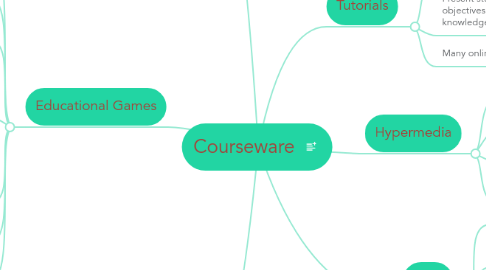Courseware
by Natasha Andre


1. Simulations
1.1. Definition
1.2. Advantages
1.2.1. Safety
1.2.2. Modification of time frames
1.2.3. Making rare events more common
1.2.4. Controlling the complexity of a phenomenon
1.2.5. Enhancement of motivation to learn
1.2.6. Transfer of learning
2. Educational Games
2.1. Popular in elementary and business schools.
2.2. Used in all phases of instruction.
2.3. Effective in integrating the use of content and skill.
2.4. Examples of games:
2.4.1. Adventure
2.4.2. Role playing
2.4.3. Logic and Puzzle
2.4.4. Word
2.5. Factors in games:
2.6. Advantages
2.7. Disadvantages
3. Tools and Open-ended Learning Environments
3.1. Constructivist approach to learning.
3.1.1. discovery, exploration, problem solving, teaching things to the computer or other students
3.2. Examples
3.3. Advantages
3.3.1. Deep learning and transfer
3.3.2. Collaborative learning
3.3.3. Motivation
3.3.4. Cross-curricular learning
3.4. Disadvantages
4. Tutorials
4.1. Address first two phases of instruction
4.2. Present students with learning objectives and stimulate prior knowledge.
4.3. Many online courses are tutorials.
5. Hypermedia
5.1. Definition
5.2. Connected through various links.
5.3. Best-know program is Wikipedia.
5.4. Support learning by:
6. Drills
6.1. Provide practice.
6.2. Before computers: drills were flashcards or workbooks.
6.2.1. Now, drills are digital flashcards or digital workbooks.
